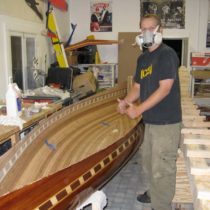Landscape Architecture for Landscape Architects › Forums › GENERAL DISCUSSION › Anything is possible-
- This topic has 1 reply, 3 voices, and was last updated 16 years, 1 month ago by
 Bob Luther.
Bob Luther.
-
AuthorPosts
-
October 30, 2009 at 1:36 pm #172480
 Ben YahrParticipant
Ben YahrParticipanthttp://www.guardian.co.uk/environment/green-living-blog/2009/oct/29/car-free-cities-neighbourhoods
‘Not anti-car, just pro-choice’ …
October 30, 2009 at 8:26 pm #172485 Bob LutherParticipant
Bob LutherParticipantI think one are that the US would have to look at is mass transit becuase we have intentionally zoned our jobs away from our homes. Nobody wants to live next to an industrial plant, and not in my backyard politics have forced most of us to be long range commuters (long range in terms, I work 17 miles from my home and go through 5 cities to get to work, which is in an unsafe and undisirable area to live but has good rental rates for office and light indutrial). If the roads in the residential areas were closed off and parking areas were pushed to the perimeter (as mentioned in the article) we could also create a light rail or mass trasit stop in those locations so in essence you could walk or bike ot the parking structure and then grab you car or your train to work…. this of course will never happen in the western US were the philosiphy of sprawl has destroyed any hope of a bike based or pedestrian society (other than the big three of Seattle, Portland, and SanFrancisco) too bad it seems like a cool concept.
October 30, 2009 at 11:00 pm #172484 Roland BeinertParticipant
Roland BeinertParticipantI recently found out about a concept called bicycle boulavards: http://www.ibpi.usp.pdx.edu/guidebook.php
Essentially, it’s a shared street with an emphasis on bikes. Cars are allowed, but low speeds discourage drivers who aren’t residents of the neighborhoods. It sounds a lot like a woonerf to me. It may be the sort of thing they have in that neighborhood called Vauben.
I’m actually in favor of methods that allow cars, but give priority to walking and biking. When you try to disallow cars completely you just end up having to build huge multi-lane roads and parking lots right outside the neighborhood. You just end up moving the problem to outside the neighborhood and aggravating it somewhat because you’re concentrating the cars.
Cars in the city should be slowed and spread out. Drivers need to be confronted with obstacles and other forms of transportation to remind them they aren’t on a highway, but on a city street. Separating car traffic by putting it on the periphery of a neighborhood still gives cars priority in that area outside the neighborhood, making it hard for bikes and pedestrians to move between neighborhoods. Does that make sense?November 2, 2009 at 2:16 pm #172483 Ben YahrParticipant
Ben YahrParticipantI think you guys are correct that it would be tough to implement this type of thing in the US. I was just excited about it because it is an example of the political will allowing changes that are typically relegated to student planning projects. The flip-side is that while car-free areas would not work everywhere in the US, they would definitely work in some areas, given a strong enough commitment to make it happen.
The guidebook that Roland posted seems like an excellent reference for many aspects of bike centered transit planning. I would prefer the prospect of car-free areas with mass transit hubs on their perimeter, but slowly making biking a more appealing option is far more realistic. As cities “upgrade” roads, the cost of adding various traffic calming measures, bike lanes, safety measures, and bike/pedestrian amenities is negligible. People need options, but they are more likely to make good decisions if the easy choice is also the right choice…
November 2, 2009 at 10:41 pm #172482 Roland BeinertParticipant
Roland BeinertParticipantBikes are a good replacement for how a lot of people currently drive. If you drive by yourself and don’t have to haul a lot, you could easily switch over to bikes or public transit. There are even some pretty good bike trailers out there. In Boise there’s one or two bike taxis. Cars don’t have much advantage in speed in Boise, either. I’ve seen cars zoom past a bicyclist then get stuck at a red light. The bicyclists and slower cars always catch up while the speeder is waiting at the red light. It’s pretty funny, although I’m not sure if the speeders notice. They’re probably too busy talking on their cell phones.
But I don’t think it’s a good idea to completely exclude cars and trucks. We need to get rid of the overuse of the car, not the car itself. Cars and trucks do fill a transportation niche. Trucks can do a fairly good job of taking lots of goods from a train to a specific store, for example. People in isolated rural areas still need something like a car or truck. If cars and trucks didn’t exist, horse and carriage would still be here. Something has to fill that role. That’s why I think roads should still allow for some cars and trucks. I guess I’m saying I’m not with the purists on this one, but I’m still on the side of bicyclists and pedestrians.
I’ve never been to any of the places mentioned in the article, so I don’t know exactly how they function. They probably allow in some cars and trucks out of necessity. If I ever go to Europe again, I’ll look for some of those places.November 2, 2009 at 11:14 pm #172481 Roland BeinertParticipant
Roland BeinertParticipantOut of curiosity I just looked up Groningen in the Netherlands (mentioned in the article ben posted) on Google Earth. From the pictures of some of the streets, it looks like it is 90% car free, but a very vital city.
-
AuthorPosts
- You must be logged in to reply to this topic.


